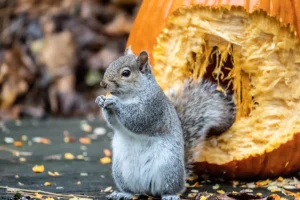Home / Blog / What are Powderpost Beetles and How to Deal With Them
What are Powderpost Beetles and How to Deal With Them

Scientifically reviewed by Daniel Baldwin, BCE, CCFS, CP-FS
-Published on May 1, 2023
-Updated on May 1, 2023
While termites might be the first pest you think of when you suspect structural damage to a home, they aren’t the only ones. Wood-boring powderpost beetles can leave a wave of destruction in their path, wreaking havoc on wooden beams, posts, flooring, and more. Difficult to detect and quick to multiply, powderpost beetles can eat away at the wood parts of a home until the damage is devastating. Read this comprehensive guide to understand powderpost beetles and how to prevent them in your home.
What are Powderpost Beetles?
“Powderpost beetle” is actually an umbrella name that describes numerous species of wood-destroying beetles, but three groups that cause the most damage are lyctids, anobiids, and bostrichids. Lyctid beetles are reddish-brown or black, and around 1/16 to 1/4 inch in size. Bostrichid beetles are also reddish-brown to black, but slightly larger, at 1/8 to 1/4 in size. Bostrichid beetles are generally wider than lyctid or anobiid beetles, and their heads are somewhat bulbous. Anobiid beetles are red to dark brown and around 1/16 to 1/8 inch in size.

How Can you Tell if Powderpost Beetles are Active?
Often, powderpost beetle colonies die out on their own, leaving a wake of costly destruction in their path, only identified after the colony has done its damage. This fact makes it crucial to know how to tell if powderpost beetles are active in your home so you can get ahead of any major expense or repair. Active powderpost beetle problems usually leave behind telltale signs. The evidence of powderpost beetles that are easiest to confirm is their frass or waste. Powderpost beetle droppings are a fine powder the color of freshly sawed wood near exit holes. If you spot a hole without any frass, the problem may have already resolved itself. Active powderpost beetle signs include small holes surrounded by a sandy or powdery pile, meaning you’re likely dealing with a dynamic situation.
Powderpost Beetle Life Cycle
Like many similar beetles, powderpost beetles pass through four distinct life stages—egg, larva, pupa, and adult. You can find the first three stages inside affected wood. While you can generally locate the adults outside of wood, they aren’t noticeable unless you’re actively searching for them and know what to look for. The larva is a creamy white, C-shaped grub with an enlarged thorax. Interestingly, this larva-stage powderpost beetle causes the most feeding damage to wood. Powderpost beetles’ life cycle varies anywhere from three months to a year. The larvae can slowly mature over a year.
Signs of a Powderpost Beetle Infestation
Powderpost beetles mainly damage wood, such as house walls, firewood piles, and furniture. Common signs of powderpost beetle damage are wood that seems to be turning to dust or decaying and crumbling for no apparent reason is a common sign of powderpost beetles. Another sign to look out for is tiny holes in wood surfaces, typically surrounded by frass. Frass may also be present in areas without visible holes and is most common on wooden porches, window sills, and furniture.
Can Powderpost Beetles Destroy a House?
Powderpost beetle damage can be extensive, second only to termites’ ability to destroy the wood in your home or furniture. They are capable of re-entering dry, seasoned wood year after year, slowly chipping away at the overall integrity of the interior structure of your home without your knowledge. With household wood getting attacked repeatedly, it becomes riddled with holes and packed with powdery frass creating weak spots. If a problem goes untreated long enough, the structural damage can lead to conditions unfit for safe living.
How to Prevent Powderpost Beetles
The best way to address a powderpost beetle problem is prevention. Avoid storing firewood indoors or directly near the home. Bring logs inside only when you’re planning to burn them immediately. Check for any insects, including powderpost beetles, before bringing natural or organic materials indoors. Do thorough checks on antique or used wooden furniture pieces which may have been sitting without use for long periods. Don’t bring wood indoors that has just been exposed to rain or any significant moisture since moist wood is an ideal condition for many destructive pests. Eliminating the food source or breeding ground indoors is the fastest way to stop a continued cycle.
Related Articles
Visit our blog to learn more.
→






